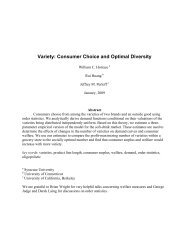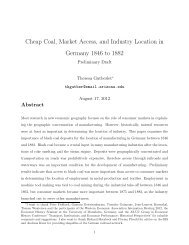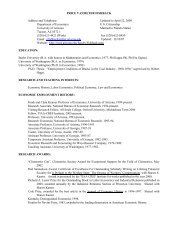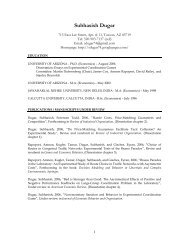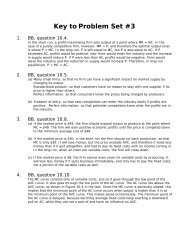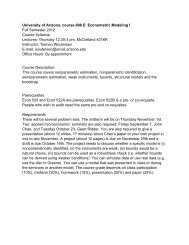A Dynamic Model of Demand for Houses and Neighborhoods
A Dynamic Model of Demand for Houses and Neighborhoods
A Dynamic Model of Demand for Houses and Neighborhoods
Create successful ePaper yourself
Turn your PDF publications into a flip-book with our unique Google optimized e-Paper software.
instead <strong>of</strong> recovering θ τ jt <strong>for</strong> every neighborhood <strong>and</strong> type, we recover ˜ θ τ jt where ˜ θ τ jt = θτ jt − mτ t<br />
<strong>and</strong> m τ t = 1/J �<br />
j θτ jt . Let ˆ P τ jt<br />
denote the estimated probability <strong>of</strong> households <strong>of</strong> type τ who<br />
choose in neighborhood j in period t. We can then easily calculate ˜ θ τ jt as:<br />
˜θ τ jt = log( ˆ P τ jt) − 1/J �<br />
k<br />
log( ˆ P τ kt ) (10)<br />
As the number <strong>of</strong> types, M, grows large relative to the sample size, we may face some small<br />
sample issues with observed shares. There<strong>for</strong>e, instead <strong>of</strong> simply calculating observed shares<br />
as the portion <strong>of</strong> households <strong>of</strong> a given type who live in an area, we use a weighted measure to<br />
avoid zero shares. We do this to incorporate the in<strong>for</strong>mation from similar types when calculating<br />
shares <strong>for</strong> any particular type. For example, if we want to calculate the share <strong>of</strong> households<br />
with an income <strong>of</strong> $50,000 choosing neighborhood j in period t, we would use some in<strong>for</strong>mation<br />
about the residential decisions <strong>of</strong> those earning $45,000 or $55,000 in that period. Naturally,<br />
the weights will depend on how far away the other types are in type space. We denote the<br />
weights by W τ (Zit). The <strong>for</strong>mula <strong>for</strong> calculating observed shares is given by: 14<br />
ˆP τ jt =<br />
� N<br />
i=1 I [di=j] · W τ (Zit)<br />
� N<br />
i=1 W τ (Zit)<br />
where the weights are constructed as the product <strong>of</strong> K kernel weights, where K is the dimension<br />
<strong>of</strong> Z. Each individual kernel weight is <strong>for</strong>med using a st<strong>and</strong>ard normal kernel, N, <strong>and</strong> b<strong>and</strong>width,<br />
hk, determined by visual inspection.<br />
K�<br />
W τ (Zit) =<br />
hk<br />
k=1<br />
(11)<br />
1<br />
N( Zit − Zτ ) (12)<br />
4.2 Estimation Stage Two - Moving Costs <strong>and</strong> the Marginal Utility <strong>of</strong> Wealth<br />
Households behave dynamically by taking into account the effect their current decision has on<br />
future utility flows. In our model, the current decision affects future utility flows through two<br />
channels. Households are aware they will incur a transaction cost by re-optimizing in the future.<br />
In addition, the decision about where to live today affects wealth in the future. Equation (8)<br />
14 If W τ (Zi) = I[Z i=Z τ ], this results in the simple cells estimator <strong>for</strong> calculating shares/probabilities.<br />
20<br />
hk



